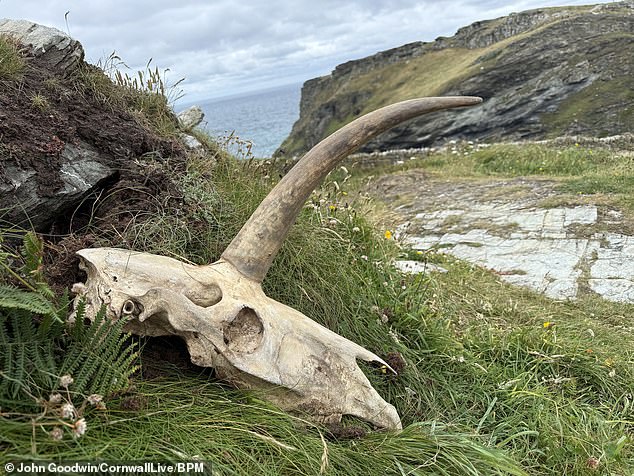[ad_1]
A mysterious skull with a huge horn poking out of it, described as a ‘unicorn’, has been unearthed near King Arthur’s castle.
The bizarre remains were dug up by Canadian tourist John Goodwin, who spotted the long horn sticking out of moss on the edge of a cliff.
The location is close to Tintagel, the castle in which King Arthur is said to have been born, which still exists in ruined form in Cornwall.
King Arthur, the legendary British leader and formidable warrior of the 5th and 6th centuries, is said to have slayed a unicorn, bringing a curse to his kingdom.
While the tourist insists he did not plant the bony remains there as a hoax, one British expert has dubbed its appearance ‘suspicious’.
‘I imagine that some people think the story isn’t true but I assure you it is true,’ Mr Goodwin told Cornwall Live.
‘It was definitely there and we found it on the trail under a mossy embankment.
‘Whether it is a genuine unicorn – that I don’t know.’

A mysterious skull with a huge horn poking out of it, described as a ‘unicorn’, has been unearthed near King Arthur’s castle

The unicorn is Scotland’s national animal and is linked with Arthurian legend, even though there’s no evidence such a creature ever existed
Mr Goodwin and his family were taking a walk at St Nectan’s Glen, a sacred valley not far from Tintagel Castle with a breathtaking waterfall considered ‘magic’ by some.
Initially, they thought the object was a root poking out, but when he pulled it free, it turned out to be the skull with the huge curving appendage.
‘I pulled it out and thought it must be a deer or something at first but realized it only had one horn,’ he told Cornwall Live.
‘It was real bone, heavy and looked properly old… it was too small for a rhino but no matter what, it was unusual.’
Mr Goodwin brought it back to his car, but reportedly his grandmother ‘started feeling uneasy’ about it right away.
‘She said it didn’t feel right to take it, like we’d disturbed something meant to be left alone,’ he added.
Mr Goodwin, a plumber, took the object to the Museum of Witchcraft and Magic in Boscastle – but the museum refused to take it.
So he left it at The Stonehenge Inn, in Durrington near Salisbury, Wiltshire, on the way back to London for another flight.

Mr Goodwin and his family were taking a walk at St Nectan’s Glen, a sacred valley in Cornwall with a breathtaking waterfall considered ‘magic’ by some

Tintagel Castle has long association with legends related to King Arthur. In the 12th century Tintagel gained literary fame when Geoffrey of Monmouth named it as the place where King Arthur was conceived
‘I decided that since I probably couldn’t take it through customs [so] I made the trade,’ he said.
The barman offered him ‘unlimited ale’ for the skull, which is still there now for punters to look at while they sip their Old Speckled Hen.
He added: ‘I call it the Sadie-James skull in honour of my gran and gramp, who had their 50th anniversary last weekend.’
Mr Goodwin admitted it is ‘certainly possible’ that some trickster planted the skull at St Nectan’s Glen as a hoax.
It could even be a fusion of two bones, stuck together to resemble that of a unicorn.
Professor David Norman, a paleontologist at the University of Cambridge, said the ‘suspicious’ item looks like ‘the skull of a deceased pony’.
‘It looks rather as though a cow horn has been glued to the top of a pony’s skull,’ he told MailOnline.
‘A lot of young girls and readers of the Skandar novels would be disappointed methinks; however it may be useful a useful publicity for the pub owner and beer sales, of course.’

King Arthur was a mythical king in the mythology of Great Britain. He lived in the medieval times, in his famous castle, Camelot. He possessed a sword known as Excalibur, given to him by the Lady of the Lake. Pictured: King Arthur by Charles Ernest Butler (1903)
The unicorn is Scotland’s national animal, even though there’s no evidence such a creature ever existed.
According to myth, King Arthur killed a unicorn in the forest when he was a prince – but Merlin, the young wizard who is Arthur’s servant, warned that it was a bad omen.
Merlin was soon proved right when a curse arrived upon the kingdom, killing crops and drying up the water.
King Arthur is said to have been conceived and born at Tintagel Castle, which was built half on the mainland and half on a jagged headland projecting into the Cornish sea.
Today’s ruined keep was built in the 13th century, but the site of Tintagel Castle has been inhabited at least since the late Roman period.
[ad_2]
This article was originally published by a www.dailymail.co.uk . Read the Original article here. .


